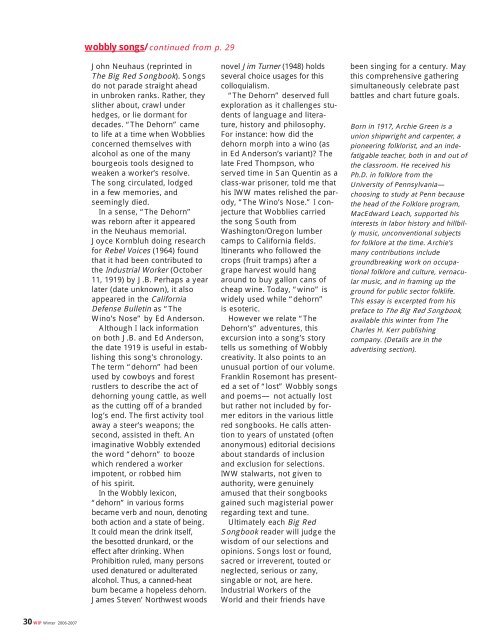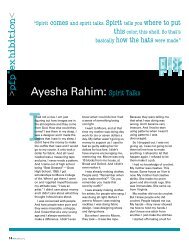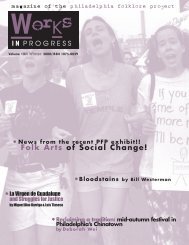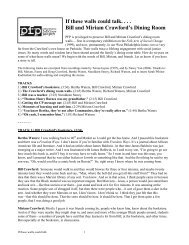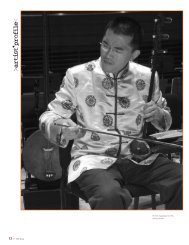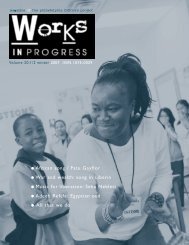View PDF - Philadelphia Folklore Project
View PDF - Philadelphia Folklore Project
View PDF - Philadelphia Folklore Project
- No tags were found...
Create successful ePaper yourself
Turn your PDF publications into a flip-book with our unique Google optimized e-Paper software.
wobbly songs/continued from p. 29John Neuhaus (reprinted inThe Big Red Songbook). Songsdo not parade straight aheadin unbroken ranks. Rather, theyslither about, crawl underhedges, or lie dormant fordecades. “The Dehorn” cameto life at a time when Wobbliesconcerned themselves withalcohol as one of the manybourgeois tools designed toweaken a worker’s resolve.The song circulated, lodgedin a few memories, andseemingly died.In a sense, “The Dehorn”was reborn after it appearedin the Neuhaus memorial.Joyce Kornbluh doing researchfor Rebel Voices (1964) foundthat it had been contributed tothe Industrial Worker (October11, 1919) by J.B. Perhaps a yearlater (date unknown), it alsoappeared in the CaliforniaDefense Bulletin as “TheWino’s Nose” by Ed Anderson.Although I lack informationon both J.B. and Ed Anderson,the date 1919 is useful in establishingthis song’s chronology.The term “dehorn” had beenused by cowboys and forestrustlers to describe the act ofdehorning young cattle, as wellas the cutting off of a brandedlog’s end. The first activity toolaway a steer’s weapons; thesecond, assisted in theft. Animaginative Wobbly extendedthe word “dehorn” to boozewhich rendered a workerimpotent, or robbed himof his spirit.In the Wobbly lexicon,“dehorn” in various formsbecame verb and noun, denotingboth action and a state of being.It could mean the drink itself,the besotted drunkard, or theeffect after drinking. WhenProhibition ruled, many personsused denatured or adulteratedalcohol. Thus, a canned-heatbum became a hopeless dehorn.James Steven’ Northwest woodsnovel Jim Turner (1948) holdsseveral choice usages for thiscolloquialism.“The Dehorn” deserved fullexploration as it challenges studentsof language and literature,history and philosophy.For instance: how did thedehorn morph into a wino (asin Ed Anderson’s variant)? Thelate Fred Thompson, whoserved time in San Quentin as aclass-war prisoner, told me thathis IWW mates relished the parody,“The Wino’s Nose.” I conjecturethat Wobblies carriedthe song South fromWashington/Oregon lumbercamps to California fields.Itinerants who followed thecrops (fruit tramps) after agrape harvest would hangaround to buy gallon cans ofcheap wine. Today, “wino” iswidely used while “dehorn”is esoteric.However we relate “TheDehorn’s” adventures, thisexcursion into a song’s storytells us something of Wobblycreativity. It also points to anunusual portion of our volume.Franklin Rosemont has presenteda set of “lost” Wobbly songsand poems— not actually lostbut rather not included by formereditors in the various littlered songbooks. He calls attentionto years of unstated (oftenanonymous) editorial decisionsabout standards of inclusionand exclusion for selections.IWW stalwarts, not given toauthority, were genuinelyamused that their songbooksgained such magisterial powerregarding text and tune.Ultimately each Big RedSongbook reader will judge thewisdom of our selections andopinions. Songs lost or found,sacred or irreverent, touted orneglected, serious or zany,singable or not, are here.Industrial Workers of theWorld and their friends havebeen singing for a century. Maythis comprehensive gatheringsimultaneously celebrate pastbattles and chart future goals.Born in 1917, Archie Green is aunion shipwright and carpenter, apioneering folklorist, and an indefatigableteacher, both in and out ofthe classroom. He received hisPh.D. in folklore from theUniversity of Pennsylvania—choosing to study at Penn becausethe head of the <strong>Folklore</strong> program,MacEdward Leach, supported hisinterests in labor history and hillbillymusic, unconventional subjectsfor folklore at the time. Archie’smany contributions includegroundbreaking work on occupationalfolklore and culture, vernacularmusic, and in framing up theground for public sector folklife.This essay is excerpted from hispreface to The Big Red Songbook,available this winter from TheCharles H. Kerr publishingcompany. (Details are in theadvertising section).30 WIP Winter 2006-2007


